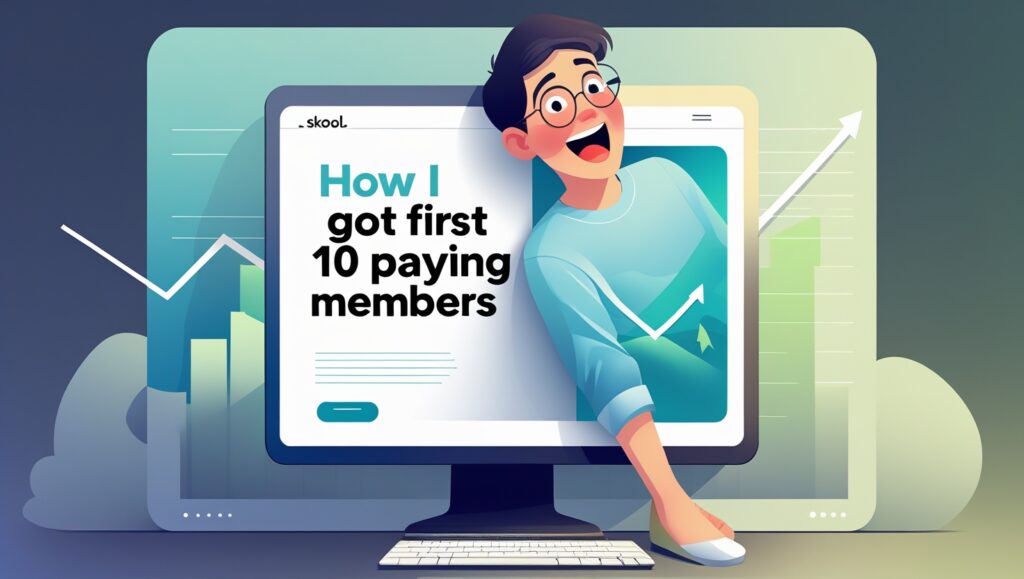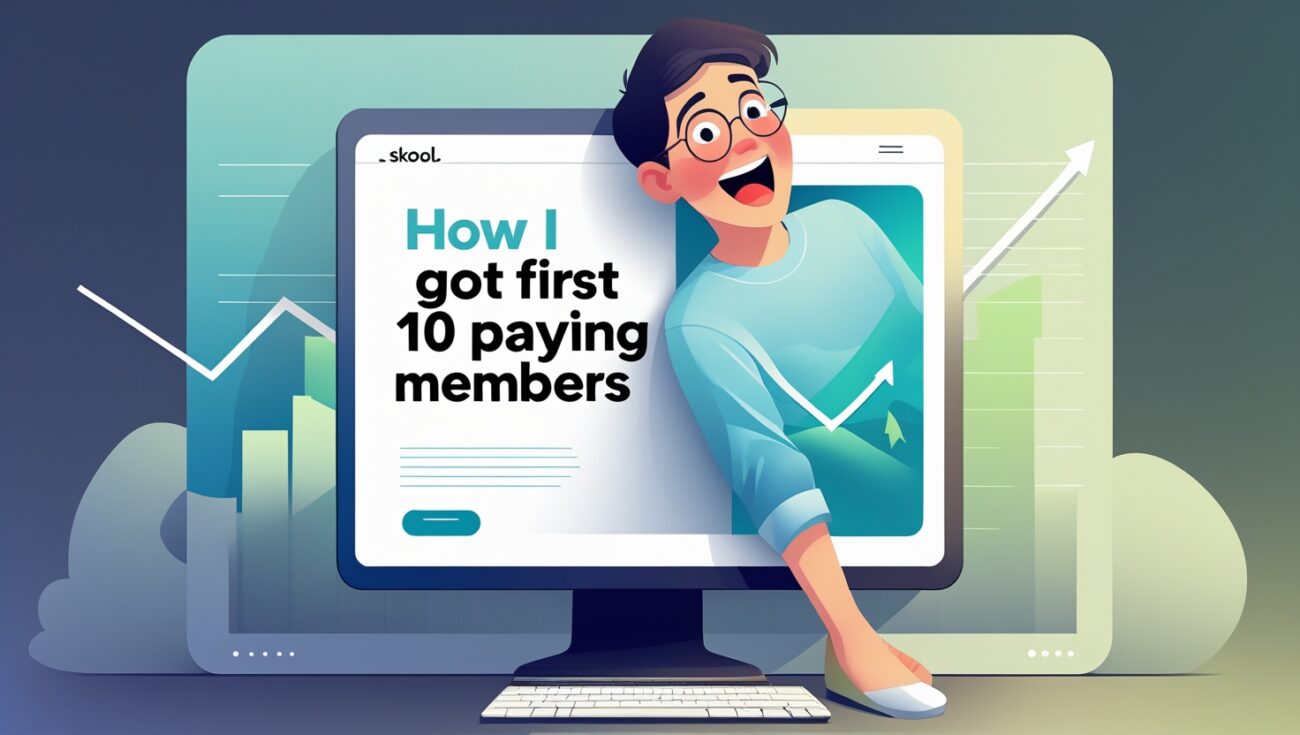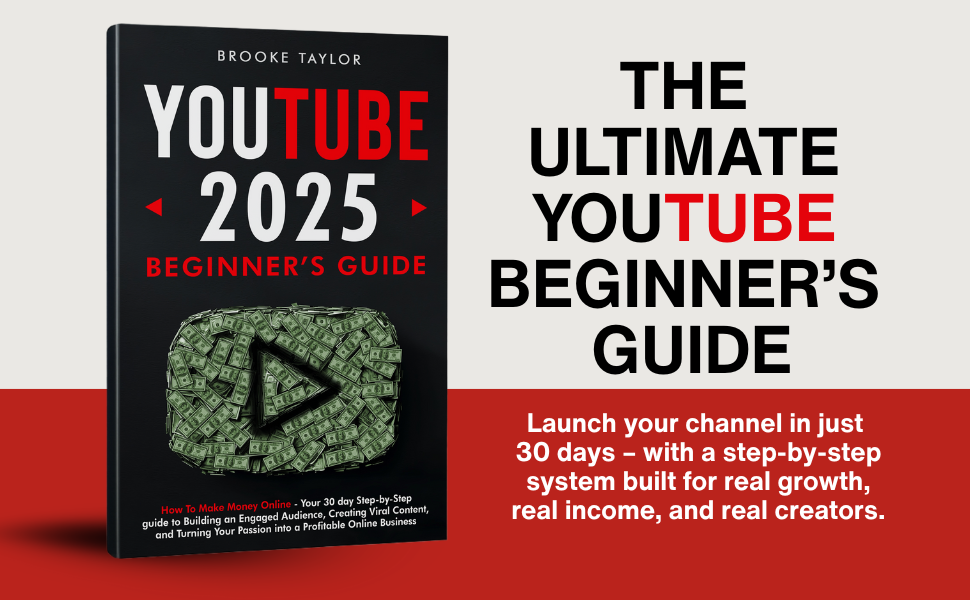How I Got My First 10 Paying Members with Skool
One of the biggest challenges when starting a paid community is getting those first 10 paying members. I remember sitting there wondering if anyone would actually join. I didn’t have a big audience, I wasn’t running ads, and I had zero tech skills. But I had something valuable to teach — and that’s really all I needed.
In this post, I’ll break down exactly how I got my first 10 members using Skool, what worked, what didn’t, and what I’d do if I were starting over again.

Table of Contents
1. I Focused on Solving a Real Problem
Before I created the group, I asked myself a simple question: What’s a problem I’ve solved that other people still struggle with? That became the focus of my community. Instead of being broad, I got specific — and that clarity helped me attract the right people faster.
I didn’t try to teach everything. I picked one topic I had real results with and built a community around that. That focus made it easier to write my sales copy, explain the group, and show how it would help.
2. I Created the Group on Skool in One Afternoon
Skool made it ridiculously easy to launch. I signed up, created my group, added a few lessons, and set the price. No WordPress, no plugins, no payment processors to hook up manually. I used Stripe through Skool, and within hours, I had a link ready to share.
Here’s my Skool affiliate link if you want to try it yourself.
3. I Pre-Sold Before I Was Ready
I didn’t wait until everything was perfect. I posted on social media and said, “I’m opening a private group where I’ll walk you through exactly how I did [insert result]. If you want in early, it’s $29/month and you’ll get lifetime access to all updates.” That created urgency and gave people a reason to join before launch.
This strategy helped me land 3 paying members before I even finished recording half the lessons. Once they were inside, I stayed transparent and kept adding content weekly.
4. I Reached Out Personally
This part took a little hustle. I went through my email list and Instagram DMs and made a list of 25 people who had previously asked me for help. I messaged them personally and said something like, “Hey! I’m starting a private group to help with exactly what you messaged me about before. Would you like the invite link?”
That personal touch converted more than anything else I tried. I wasn’t spamming — I was following up with people who had already shown interest. Five of them joined.
5. I Shared Behind-the-Scenes Content
I posted on Instagram Stories and inside my free email newsletter about building the group. I showed sneak peeks of the course layout, lesson titles, and community features. People love watching something being built, and it made them feel like they were part of the process.
That transparency built trust. By the time I opened the doors, they felt like they’d seen the whole journey — and joining felt like a natural next step.
6. I Offered a Founding Member Bonus
To push people to take action quickly, I offered something special for the first 10. In my case, it was a free 30-minute coaching call and lifetime access to future courses I planned to add inside the community. That small bonus added value without taking too much of my time.
It created urgency, but more importantly, it showed people I was committed to making the group valuable long-term.
7. I Used Skool’s Built-In Simplicity to My Advantage
Skool did a lot of heavy lifting for me. The platform looks clean and professional even without branding. I didn’t have to explain how to use it. The classroom, calendar, and feed were self-explanatory, and that gave people confidence to join.
I believe part of the reason I got those first members was because they felt safe in the system — it didn’t look like a startup or sketchy site. It looked real.
8. I Kept It Simple and Affordable
My initial offer wasn’t $199 or some high-ticket monthly fee. I started small — $29/month — with clear, focused value. That made it easy for people to say yes, especially since they were already following my content.
Once I hit 10 members and got positive feedback, I raised the price confidently.
9. I Added Quick Wins Inside the Course
The first thing I wanted new members to feel was progress. So I uploaded a few short lessons they could implement right away and get results. When people feel results early, they stick around — and they tell others.
A few even shared the group with friends, which helped me grow organically.
10. I Reinforced the Community Aspect
People don’t just pay for content — they pay for connection. I encouraged everyone to introduce themselves and post questions. I replied to every post in the beginning to spark conversation. That made the space feel alive, not empty.
This is what keeps people subscribed, and it’s why Skool makes building a paid group easier than any other tool I’ve tried.
11. I Promoted My Group in Evergreen Content
After getting those first 10 members, I wrote blog posts and made YouTube videos where I shared my Skool journey — and dropped my affiliate link. Now, months later, those posts continue to bring in new members and affiliate income passively.
Skool’s simplicity let me focus on promotion, not tech. And that’s what grew the group.
12. I Let the Group Become My Proof
Once the group had real members and engagement, it became the proof I needed. Now, when people ask what I offer or how I help others, I just send them my Skool group. That link does the selling for me.
If you’re thinking about starting your own group, you don’t need a big list or a fancy strategy. You just need a platform like Skool, a clear offer, and the willingness to talk to people.
Here’s my affiliate link to get started with Skool. If I could do it with zero experience and no audience, so can you.
Looking back, I think the most important thing I did was not wait for everything to be perfect. I’ve seen so many people stuck trying to build funnels, websites, and complicated tech stacks, and that keeps them from actually launching. Skool removed that barrier for me. I had no excuse — it was all ready to go in one place.
I also didn’t try to hide that I was just getting started. I told people, “Hey, this is new, but if you join now, you’ll get in early and help shape it.” That made them feel like founders. And people love to be part of something at the ground level.
A big shift happened when I realized I wasn’t selling a course — I was selling access to me. Most people joined not just for the lessons, but because they wanted someone who had done it and could answer their questions. That’s the power of a community format. You’re not just creating content; you’re guiding people.
Another strategy that helped was sharing wins publicly. As soon as I got the first few members, I posted about it. “Just got my 4th member in the group — thank you for the support!” That social proof encouraged others to jump in too. It created momentum I didn’t have to force.
Skool’s mobile experience also helped more than I expected. A lot of my members prefer using their phones, and since Skool works smoothly on mobile, it didn’t create any friction. No one had to download an app or learn a whole system — it just worked.
I also liked that I could track engagement inside the platform. I saw who was logging in, who was completing modules, and who was posting. That helped me follow up with members individually, which made a difference in retention.
The notification system kept my group alive. When someone asked a question, I got an email instantly, and I made it a habit to reply fast. That made members feel supported, especially early on, and encouraged others to join the conversation.
As people started getting results from my content, they started talking about the group publicly. I had one member share a testimonial on Twitter and another write a blog post about their experience. That wasn’t planned, but it brought in even more credibility.
One thing I always tell people now is: don’t focus on scaling too soon. Focus on serving your first 10 people deeply. Overdeliver. Be responsive. Make sure they’re happy. That’s the foundation of a healthy recurring income stream.
I also set clear expectations. I told them what they’d get each week — whether it was a lesson, a Q&A, or a community check-in. That consistency helped them build a habit of logging in, and habits lead to retention.
My affiliate income also started when I shared my journey of building the group. People asked what I was using, and I simply replied with: “I’m using Skool. Here’s my link if you want to check it out.” That soft pitch led to commissions on autopilot.
If you’re serious about building a simple, clean, and effective paid community, I highly recommend Skool. I’ve used other platforms, but this is the one that helped me go from 0 to 10 members — and I’m still growing.






